|
|
 |
|
Calanoida ( Order ) |
|
|
|
Eucalanoidea ( Superfamily ) |
|
|
|
Eucalanidae ( Family ) |
|
|
|
Eucalanus ( Genus ) |
|
|
| |
Eucalanus californicus Johnson, 1938 (F,M) | |
| | | | | | | Syn.: | Eucalanus giesbrechti Mori, 1937 (1964) (p.22, figs.F, juv.M); Hernandez-Trujillo, 1989 a (tab.1); Cervantes-Duarte & Hernandez-Trujillo, 1989 (tab.3); Hernandez-Trujillo & Esqueda-Escargera, 2002 (in Appendix);
Eucalanus bungii californicus M.W. Johnson, 1938 (p.169, fig.F, Rem.); Davis, 1949 (p.17, figs.F,M); ; Brodsky, 1950 (1967) (p.101, 102, fig.F); Tanaka, 1956 (p.268, figs.F, Rem.); Fleminger, 1967 a (tabl.1); Furuhashi, 1966 a (p.295, vertical distribution vs mixing Oyashio/Kuroshio region, Table 10); Park, 1968 (p.540, Pl. 4, fig.3, Rem.); Morris, 1970 (p.2300); Star & Mullin, 1981 (p.1322, abundance); Van der Spoel & Heyman, 1983 (p.94, fig.58); Cervantes-Duarte & Hernandez-Trujillo, 1989 (tab.3); Hernandez-Trujillo, 1991 (1993) (tab.I); 1999 (p.284, tab.1); Hernandez-Trujillo & Suarez-Morales, 2002 (p.748, tab.1);
Eucalanus elongatus : Esterly, 1905 (p.131, figs.F,M) | | | | Ref.: | | | Fleminger, 1973 (p.978, 987, 998); Dawson & Knatz, 1980 (p.4, figs.F,M); Gardner & Szabo, 1982 (p.154, figs.F,M); Brodsky & al., 1983 (p.208, figs.F, Rem.F,M); Chihara & Murano, 1997 (p.789, Pl.98,102: F,M); Goetze, 2003 (p.2322 & suiv.) |  issued from : T. Park in Antarct. Res. Ser. Washington, 1968, 66 (3). [p.539, Pl.4, Fig.3]. As Eucalanus bungii californicus. Female (from tropical-subtropical Central North Pacific): 3, Md (mandibular palp. Nota: The basis of the mandibular palp has a 1 seta.
|
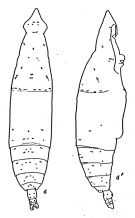 issued from : A. Fleminger in Fishery Bull. natn. Ocean. Atmos. Adm., 1973, 71 (4). [p.989, Fig.13]. Female: d, habitus (dorsal), d', idem (lateral right side).
Dorsal and lateral pattern of integumental organs (black point = sites occuring at 100% frequency, o = 80-99% frequency, x = 10-79% frequency, triangle are sites which are also visible in lateral view but which are assigned to dorsal sets)
|
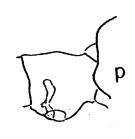 issued from : A. Fleminger in Fishery Bull. natn. Ocean. Atmos. Adm., 1973, 71 (4). [p.968, Fig.1, p (p.969)]. Female: p, genital segment (lateral right side).
|
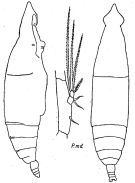 issued from : K.A. Brodsky, N.V. Vyshkvartzeva, M.S. Kos & E.L. Markhaseva in Opred Fauna SSSR, 1983, 135. [p.208, Fig.95]. Female Nota: habitus from Fleminger, 1973 (redrawn); Pmd from Johnson, 1938.
|
 issued from : C.O. Esterly in Univ. Calif. Publs Zool., 1905, 2 (4). [p.132, Fig.6]. As .
Female (from San Diego Region): a-b, habitus (dorsal and lateral, respectively).
Male: c, forehead (dorsal); d, P5 (left foot at left of figure).
|
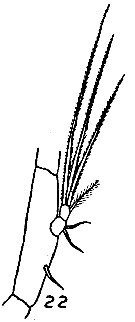 issued from : MW. Johnson in Bull. Scripps Instn Oceanogr., techn. Ser., 4 (6). [p.169, Fig.22]. As Eucalanus bungii californicus. Female (from California): 22, Md (mandibular palp). Nota: Left A1 is the heavier and overreaches the caudal rami by about 5 to 6 segments, wereas the right A1 overreaches the rami by only 3 to 4 segments. 1 single seta on the 2nd mandibular basis of the palp of Md. In the adult Male only a small papilla or scar (after aptophy of the mouth parts), remain to indicate the number of setae that were present in the submatures stages
| | | | | Compl. Ref.: | | | Ahlstrom & Thrailkill, 1963 (p.57, Table 5, abundance); Fleminger & Hulsemann, 1973 (p.343, carte); Ohman, 1988 (p.143, Table 1: lipid content); Landry & al., 1994 (p.55, abundance, grazing); Suarez-Morales & Gasca, 1998 a (p.109); Ohman & al., 1998 (p.1709, organic composition, vertical distribution, ETS activity, egg production, dormancy: Table 3); Gomez-Gutiérrez & Peterson, 1999 (p.637, Table I, II, III, VI, figs.4, 5, 6, 7, abundance, egg production); Rebstock, 2001 (tab.2, 4); Peterson & al., 2002 (p.353); Peterson & al. 2002 (p.381, Table 2, interannual abundance); Rebstock, 2002 (p.71, Table 3, 5, 6, Fig..2, climatic variability); Rau & al., 2003 (p.2431, N variations vs climate variability 1950-2000); Peterson & Keister, 2003 (p.2499, interannual variability); Keister & Peterson, 2003 (p.341, Table 1, 2, abundance, cluster species vs hydrological events); Mackas & al., 2004 (p.875, Table 2); Shimode & al., 2005 (p.113 + poster); Lavaniegos & Jiménez-Pérez, 2006 (p.142, tab.2, 3, Rem.); Mackas & al., 2006 (L22S07, Table 2); Ware & McQueen, 2006 (p.28, Table B1, weight ranges); Papastephanou & al., 2006 (p.3078, Table 3); Galbraith, 2009 (pers. comm.); Chiba & al., 2009 (p.1846, Table 1, occurrence vs temperature change); Goetze & Ohman, 2010 (p.2110, Table 1, biogeography); Shimode & al., 2012 a (p.1, life history); Ohman & al., 2012 (p.46, N variations as index of climate variations over 54-year time period); in CalCOFI regional list (MDO, Nov. 2013; M. Ohman, comm. pers.); Kobari & al., 2013 (p.78, Table 2); Hirai & al., 2013 (p.1, Table I, molecular marker); Baumgartner & Tarrant, 2017 (p.387, Table 1, diapause, Rem.); Record & al., 2018 (p.2238, Table 1: diapause); Hirai & al., 2020 (p.1, Fig. 5: cluster analysis (OTU), spatial distribution). | | | | NZ: | 4 | | |
|
Distribution map of Eucalanus californicus by geographical zones
|
| | | | | | 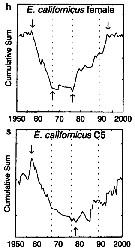 issued from : G.A. Rebstock in Global change Biology, 2002, 8. [p.77, Fig.2 h, s]. issued from : G.A. Rebstock in Global change Biology, 2002, 8. [p.77, Fig.2 h, s].
Climatic regime shifts and decadal-scale variability in calanoid copepod populations off southern California (31°-35°N, 117°-122°W.
Cumulative sums of nonseasonal anomalies from the long-term means of copepod abundance from years 1950 to 2000.
A negative slope indicates a period of below-average anomalies; a positive slope indicates a period of above-average anomalies. Abrupt changes in slope indicate step changes. Step changes are marked with arrows (upward-pointing for increases, downward -pointing for decreases).
The October 1966 cruise (prior to the increase in sampling depth), March 1976 cruise (prior to the 1976-77 climatic regime shift), and October 1988 cruise (prior to the hypothesized 1989 climatic regime shift) are marked with vertical lines. |
 Issued from : S. Shimode, K. Takahashi, Y. Shimizu, T. Nonomura & A. Tsuda in Progress in Oceanography, 2012, 96. [p.11, Fig.10, a]. Issued from : S. Shimode, K. Takahashi, Y. Shimizu, T. Nonomura & A. Tsuda in Progress in Oceanography, 2012, 96. [p.11, Fig.10, a].
Schematic illustration of the most probable life cycle of Eucalanus californicus (a). Ontogenetic vertical migration during the year in the Kuroshio-Oyashio transition area
C = copepodite stage; F = female adult; M = male adult.
Compare with Eucalanus bungii reported in the Oyashio region modified from Tsuda & al. (2004) and Shoden & al. (2005).
Nota:
Gonadal analysis of adult females showed that surface reproduction occurs during the spring in the slope water area, which is a region on the continental slope north of the Kuroshio axis, and within the Kuroshio-Oyashio transition area.
The seasonal ontogenetic vertical migration strategy in the NW Pacific is characterized by shorter periods of surface reproduction and growth, deep copepodite stage 5 dormancy (500-2000 m). This strategy of deep dormancy is considered to be an adaptation to avoid drift caused by a local oceanic feature of deeper westward (> 1000 m) recirculation currents, thus retaining the population within the high primary production zones of the Kuroshio-Oyashio transition area and slope water area. |
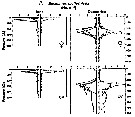 Issued from : M.D. Ohman, A.V. Drits, M.E. Clarke & S. Plourde in Deep-Sea Res. II, , 1998 , 45. [p.1719, Fig. 4 A]. Issued from : M.D. Ohman, A.V. Drits, M.E. Clarke & S. Plourde in Deep-Sea Res. II, , 1998 , 45. [p.1719, Fig. 4 A].
Vertical distribution of copepod in the San Diego Trough in June and December. Adult female and copepodid stage V of Eucalanus californicus.
Dark symbols illustrate nightime distributions, open symbols illustrate daytime distributions, each plotted at the mid-point of the sampling interval. Sampling extended deeper in December than in June.
Sampling out in the San Diego Trough (near 32°50'N, 117°40'W) in 6-14 June 1992 and 15-22 December 1992.
The species is dormant as both adult females and copepodid V's, although winter females respond relatively rapidly to elevated food and temperature conditions; they begin feeding and producing eggs within 2-3 days. |
 Issued from : M.D. Ohman, A.V. Drits, M.E. Clarke & S. Plourde in Deep-Sea Res. II, , 1998 , 45. [p.1730, Table 3]. Issued from : M.D. Ohman, A.V. Drits, M.E. Clarke & S. Plourde in Deep-Sea Res. II, , 1998 , 45. [p.1730, Table 3].
Differential dormancy of co-occuring copepods in the California Current System in the San Diego Trough.
Indices used to differentiate actively growing from dormant animals included developmental stage structure and vertical distribution; activity of aerobic metabolic enzymes (Citrate Synthase and Electron Transfer System complex); investment in depot lipids (wax esters and triacylglycerols); in situ grazing activity from gut fluorescence, and egg production rates. |
| | | | Loc: | | | N Pacif. (Hecate Strait, Oregon (off Newport), California, Santa Monica Basin, W Baja California - Japan), China seas (East China Sea), Japan (Kuroshio-Oyashio trnsition area) | | | | N: | 40 | | | | Lg.: | | | (22) F: 7-5,9; (72) F: 6,4-5,28; (125) F: 6,18; (131) F: 5,9-7; (142) F: 7,5-4,4; M: 4; (866) M: 4,5-5; {F: 4,40-7,50; M: 4,00-5,00} | | | | Rem.: | Between 3o°-50° N in the Pacific Ocean.
According to Park (1968, p.540) this form seems in favor of Johnson's treatment of elevating this variety to specific level in the absence of any intermediate forms (contrary to the opinion of Vervoort, 1946). | | | Last update : 28/10/2020 | |
|
|
 Any use of this site for a publication will be mentioned with the following reference : Any use of this site for a publication will be mentioned with the following reference :
Razouls C., Desreumaux N., Kouwenberg J. and de Bovée F., 2005-2025. - Biodiversity of Marine Planktonic Copepods (morphology, geographical distribution and biological data). Sorbonne University, CNRS. Available at http://copepodes.obs-banyuls.fr/en [Accessed October 20, 2025] © copyright 2005-2025 Sorbonne University, CNRS
|
|
 |
 |













